This month in the BBA Challenge, we’re baking through the sourdough series in the Bread Baker’s Apprentice. Basic Sourdough Bread is the 30th bread in the challenge. I decided to wait until January to start this series so that I would be fresh. I’m so glad I took a break during the Holidays because now I’m able to slow down and use this challenge as more of a learning process rather than just trying to finish the breads in the book. Like so many of the other bread-bakers participating in the challenge, I had gotten a little burnt out, but it’s a new year and a new day and I’m ready to rock and roll again.
With the BBA method, you begin the process of making sourdough bread by creating a seed culture using a mixture of 1 cup of rye flour and 3/4 of water. Then you feed the culture a mixture of 1 cup of bread flour (or high-gluten flour) and 1/2 cup of water each day for 3 more days until it is ready to be turned into the mother starter. It took about 6 days (rather than 4) to develop my seed culture because it was cold in my kitchen and it took longer to ferment. I started this process over the Holidays so the barm would be ready to use in January.
I really like my existing sourdough starter so I almost just used it instead of creating a new one, but for the sake of the challenge, I decided to create the starter from the formula in the book and note the difference between the two starters. Peter Reinhart usually has such great techniques and methods, I figured I couldn’t go wrong using his formula.
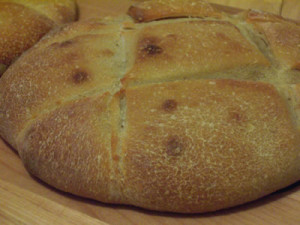
Basic Sourdough Bread
Makes: Two medium loaves
From: The Bread Baker’s Apprentice by Peter Reinhart
Ingredients:
Firm Starter:
- 2/3 cup barm (see below)
- 1 cup unbleached high-gluten or bread flour
- 1/8 to 1/4 cup water
Final Dough:
- 4 1/2 cups unbleached high-gluten or bread flour
- 2 teaspoons salt
- 1 1/2 to 1 3/4 cups water, lukewarm
- Semolina flour or cornmeal for dusting
Directions:
Friday Night: Make the Barm (or Mother Starter)
- 3 1/2 cups unbleached high-gluten or bread flour
- 2 cups water, at room temperature
- 1 cup seed culture
Once the seed culture is ready, make the barm. Stir together the flour, water, and seed culture in a mixing bowl. Make sure the seed culture is evenly distributed and all of the flour is hydrated. It will make a wet, sticky sponge.
Transfer the sponge to a clean plastic, glass, or ceramic container. Cover the container with a lid or plastic wrap and let it ferment at room temperature for about 6 hours, or until the barm is bubbly. Open the lid or remove the plastic wrap and let the gas escape.
Replace the cover and refrigerate the barm overnight before using. The barm will be ready to use the next day and will remain potent for 3 days before you have to refresh it.
Once the barm is ready, it is used as the starter for making the sourdough bread. Just feed it on a regular basis to keep it alive.
Saturday: Prepare the Starter
To make the starter for the Basic Sourdough Bread, remove the barm from the refrigerator and measure out the appropriate amount by dipping a measuring cup into water, then scoop out the barm.
Transfer the barm to a small bowl and cover with plastic wrap. Allow it to warm up for 1 hour.
Add the flour to the bowl and mix together the barm and the flour.
Add only as much water as needed to knead it into a small ball. It should be the texture of French bread dough. Just work it long enough to be hydrated and evenly distribute the barm.
Fermenting the Starter
Lightly oil a small bowl and place the starter in the bowl, rolling it around in the bowl to coat it with oil. Cover the bowl with plastic wrap. Let the starter ferment at room temperature for 4 hours, or until the starter has at least doubled in size. If it takes more time than 4 hours, give it additional time, checking every hour or so.
I took my barm out of the refrigerator Saturday morning and created the starter. I let the starter sit all day – about 8 or 9 hours. It never really doubled in size. It was too cold in my kitchen. I finally just put it in the refrigerator overnight.
Sunday: Make the sourdough Bread (or not!)
On Sunday, I decided to go ahead and make the bread to find out if the starter would work (or not). I took the starter out of the refrigerator. I was supposed to be able to cut it into pieces and let it sit for an hour to take the chill off, but it was too gooey to cut into pieces, so I just let it sit in the bowl for an hour. My other starter is more liquid so I thought it would be okay to use this version instead of a firm starter – especially since I didn’t seem to have one. In Peter Reinhart’s commentary, he encourages us to veer from his method or modify either the technique or the ingredients. So that’s what I did.
Making the Dough
To make the dough, stir together the flour and salt in a mixing bowl. Add the starter and enough water to bring everything together into a ball, stirring with a large spoon.
You can use your mixer for this part, but I just used my handy-dandy dough whisk.
Kneading the Dough
Sprinkle flour on the counter and transfer the dough to the counter. Knead the dough for about 12 to 15 minutes. Adjust the water or flour as necessary.
It took longer than 15 minutes to knead this dough. I may have kneaded it too much but it just wasn’t firm and tacky. Finally, I got the right consistency.
Fermenting the Dough
Lightly oil a bowl and transfer the dough to the bowl. Roll it around in it to coat it with oil. Then loosely cover the bowl with plastic wrap. Let it ferment at room temperature for 3 to 4 hours, or until nearly doubled in size.
Shaping the Loaves
Remove the dough from the bowl and divide it into 2 equal pieces.
Gently shape the dough into boules, baguettes, or batards. I decided to make a boule to compare it to the KAF sourdough bread I made the other day.
Proofing the Dough
You can proof the dough in a banneton or a proofing bowl. I don’t have a banneton so I decided to make a proofing bowl. I used a medium-sized plastic bowl and a wooden bowl and covered them with a kitchen towel sprayed with cooking spray and dusted with flour.
This part took longer than 2 to 3 hours and I was getting tire about now so I covered the bowls (covered with plastic wrap) in the refrigerator to retard overnight.
Monday: Making the Bread (I hope)
I took the bowls out of the refrigerator and let the boules sit for several hours. More than the 4 hours that the book mentions will be necessary if you retard it overnight – it was probably more like 6 or 7 hours. They rose a good bit (after I placed the bannerols in the oven with a glass measuring cup full of very hot tap water) but they didn’t double in size.
Baking the Loaves
I finally decided it was time to bake these loaves so I prepared the oven for hearth baking (pages 91-94) and preheated the oven. Then I removed the loaves from the bowls and transferred them to a parchment paper sprinkled with cornmeal. Then I scored the loaves.
I used a baking peel to transfer the the loaves (on the parchment paper) to the preheated baking peel. At this point, the loaves were sort of flat, but I was hoping they would have “oven spring” like the classic sourdough bread I made with my other starter.
I baked the loaves for about 10 minutes, then rotated them for even baking and baked them about 15 more minutes. The loaves rose a little bit but not very much. I even used the steam pan method and spritzed the walls of the oven with water, but it didn’t really help much in this instance.
I believe this starter needed a little assistance since it wasn’t fully developed yet. It took so long to get the barm and the starter going, that should’ve been my queue to add a little bit of dry yeast but I didn’t. So there you have it…
After the loaves were finished, I transferred them to a wire rack and let them cool for about 45 minutes. Once they are cooled, they are ready for slicing and eating.

Happy Baking!
Cathy
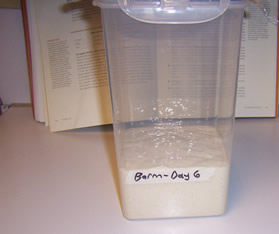
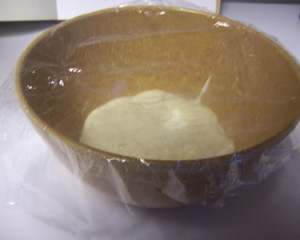
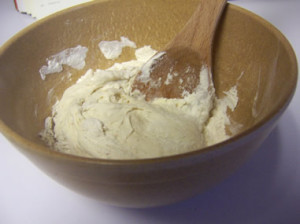
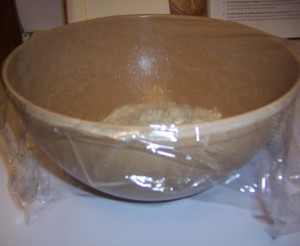
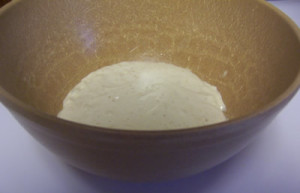
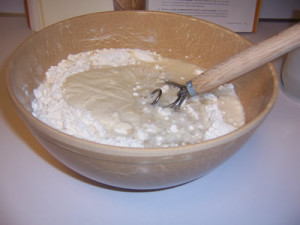
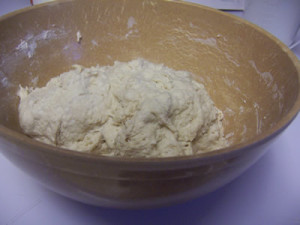
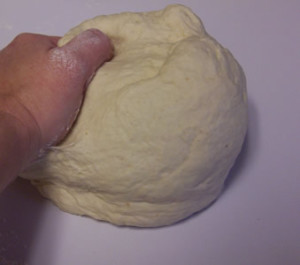
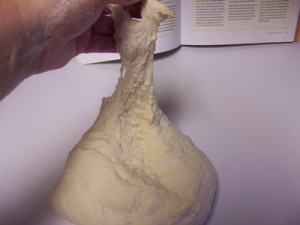
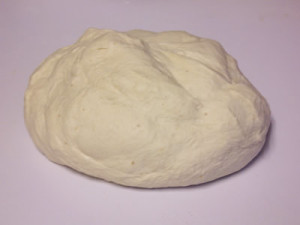

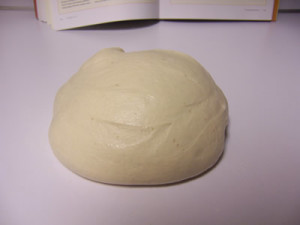
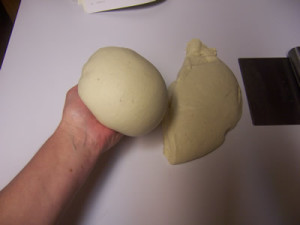
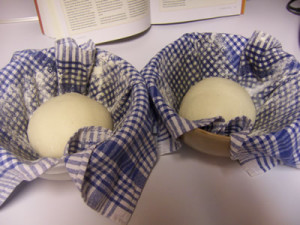
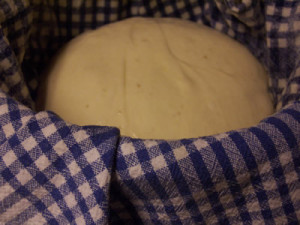
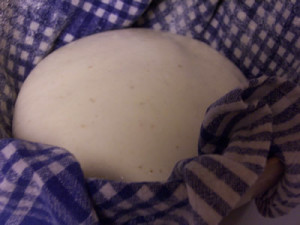

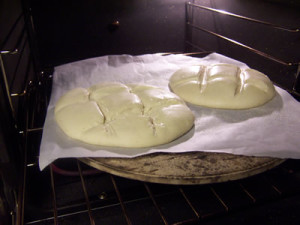
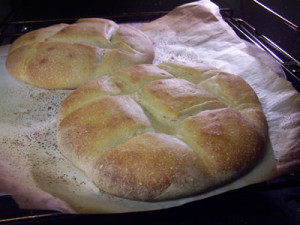
Mags says
I think it looks fabulous Cathy. I’m looking forward to hearing if you enjoyed the taste.
Cathy (breadexperience) says
Thanks Mags! I’ll let you know when I try it.
Cristie says
My sour dough starter has dried up, so sad. Your loaves look wonderful and I’m sure that coming from your kitchen they will have a delicious flavor.
Cathy (breadexperience) says
Thanks Cristie! I’m sorry your sourdough starter dried up, but you can always create a new one.